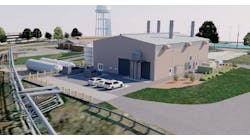We explore the opportunities nanogrids provide for the solar installers in a new special report series brought to you by Microgrid Knowledge and Instant ON. The first article defines nanogrids, explains how they’re installed, why they’re prices have fallen and how they derive value.
Get the full report.
What exactly are nanogrids? Think of a microgrid, but:
- Smaller, which means quicker and easier to deploy and more affordable
- Localized, so customer centric and able to be tied to other nanogrids, microgrids and the utility macrogrid
- Able to be aggregated, which can create a coordinated response to support other grids in times of emergencies
Both nanogrids and microgrids are forms of local energy—self-sufficient systems with power generation, controls and often energy storage—that serve customers within a discrete footprint. Although they can operate on their own, most North American microgrids and nanogrids are also connected to the central grid. They are able to island from the larger grid and operate independently during power outages. Electricity continues to flow to homes and buildings served by microgrids and nanogrids even as others around them are in the dark. This is a prime reason for their installation, one that is especially important given that the U.S. is experiencing more outages caused by storms, wildfires and other dangerous conditions that affect the safety of communities. Meanwhile, power outages to homes, a prime market for nanogrids, are no longer a mere inconvenience; they can carry significant costs now that more people are working from home. Indeed, COVID-19 created situations where high ranking corporate officials were operating from their houses, shifting the corporations’ de facto headquarters to residences that lack the kind of backup energy systems more likely to be found at their office complexes.
But it’s not only electric reliability that makes these systems attractive. Because they are tied to the electric grid, they may supply services to it and be paid for doing so. For example, a utility might pay to tap into a nanogrid’s battery at a time when demand is high on the electric grid and it needs more energy, such as a hot day when air conditioning use is high.
Nanogrid and microgrid owners also can save money if they use energy from their systems, instead of the grid, during times when grid power is expensive.
Another important benefit of nanogrids is their interconnectivity to a larger scale smart grid. An aggregated network of nanogrids can be very valuable to the grid. Currently, solar is generating power at times of the day when energy is at lowest demand. Besides simply turning off the solar panel production, through a practice called curtailment, the utilities do not have an effective way of managing all the separate points of intermittent connection. They don’t have a way to store the solar power effectively. In addition, at times when the utilities need the power most, current independent solar systems cannot necessarily supply it because they lack the intelligent technology to do so. This is partially due to the fact that the solar energy is not being produced at those critical times of the day. Nanogrids can help solve this problem.
How do microgrids and nanogrids differ? Size is one major factor that distinguishes them. Microgrids tend to be larger than nanogrids, and they usually serve the entire building or more than one building. Microgrids also may incorporate relatively complex energy systems with multiple sources of energy. According to a paper published by Bruce Nordman, a researcher at the Lawrence Berkeley National Lab, and Ken Christensen, a computer science professor at the University of South Florida, a nanogrid is a single domain of power — for voltage, capacity, reliability, administration and price.
What solar installers need to know about installation & equipment
Many existing solar companies and a few new companies are getting into the energy business and recognizing that nanogrids add value when compared to simple stand-alone solar systems. Nanogrids must be professionally designed, built and installed because of safety and technical issues. Installers must understand still evolving standards for net energy metering (NEM), UL certification and communications, interconnection, and requirements for different types of electrical experience, as well as export guidelines that vary city by city and utility by utility. Needed now are teams of experts who can successfully commission and install nanogrid projects. The learning curve is almost insurmountable for small contractors unless they have a team, or partner, that understands the ever changing environment surrounding the various components of a nanogrid.
The right equipment is a critical part of the package and can help determine whether a nanogrid can isolate from the grid. That’s key because most homeowners interested in solar and storage seek resiliency and want to be able to maintain power in their home in the event of a power outage.
During a power outage, a solar system stops operating to prevent the backflow of energy.
It’s important for solar installers to understand the equipment necessary to allow the home to be islanded in the event of a power outage. During a power outage, a solar system stops operating to prevent the backflow of energy. (The aim is to protect utility linemen.) This was the case for hundreds of Californians who had their electricity shut off during public safety power shut-offs (PSPS)—despite having solar.
In some cases, even homes with solar and energy storage systems saw their electricity cut when the utility shut down power in their neighborhoods. These systems lacked a key component of a nanogrid, an element that distinguishes the technology from simpler solar plus storage systems—an automatic transfer switch.
A transfer switch isolates the system from the utility and puts the nanogrid in island mode. This allows the nanogrid to provide power from its on-site resources to the home without backfeeding to the grid. When the outage ends and grid power becomes available, the transfer switch reconnects the home to the grid, allowing power to again flow between the nanogrid and grid. In some cases, other equipment may be necessary, such as a non-export relay that provides redundancy for the utility.
All of this equipment must be managed, which is the task of the controller, the final piece needed to ensure proper function, monitoring and operation. This highly intelligent software-based system also gives the nanogrid capabilities not available to mere solar or solar plus storage systems. With advanced controls, consumers gain visibility into and control of their electricity consumption, which enables the smooth integration of alternative energy sources into the existing wiring infrastructure. They are also able to conveniently participate in utility demand response programs, which offer the household compensation for saving energy at key times. The controller offers automation and load prioritization that allows for maximum compensation with minimum disruption.
Another component beginning to be introduced to nanogrids is the intelligent circuit panel, which offers services well beyond the conventional panel’s passive current protection. An intelligent panel combines critical components (smart meter, circuit panel and essential loads panel) to create a single point of control for generation, energy storage and smart devices in the home. So, when there is a grid outage, the panel automatically islands the house and controls loads to ensure safe and seamless transition from grid to island mode and back to the grid. Innovative systems allow the homeowner, via a cell phone, to prioritize energy use for circuits, appliances and connected devices, ensuring that the most important are energized or de-energized as necessary. As a result, the home can operate for a longer period using only on-site energy. The battery power isn’t wasted on appliances that are not a priority to the homeowner.
Solar and storage price drops create opportunities
By EyeLights West/Shutterstock.com
Nanogrids arrive at a time when the price of their main components—solar and storage—are falling.
The cost of installing solar panels has decreased by more than 70% in the last 10 years, according to the Solar Energy Industries Association (SEIA). While the average residential system cost about $40,000 in 2010 before incentives were applied, it’s now only $18,000, SEIA says. Prices as of the first quarter of 2020 were at their lowest levels in history for all solar market segments.
The price of lithium ion batteries has dropped by about 80% over the last five years. And, the cost is still falling. Lithium ion batteries are expected to drop at an average annual rate of 6.5% for the next decade.
As for storage, since 2013, the prices for lithium ion batteries, the most common form of battery used in nanogrids, have dropped by nearly 73%, with the combined cost for a cell and pack at $176 in 2018, $474 less than in 2013, according to the Smart Electric Power Alliance.
The National Renewable Energy Laboratory (NREL) says that the price of lithium ion batteries has dropped by about 80% over the last five years. As a result, the U.S. deployed 93% more storage in the third quarter of 2019, compared to the third quarter of 2018.
Navigant Research in August 2019 released a report saying the prices of lithium ion batteries are expected to drop at an average annual rate of 6.5% for the next decade.
The declining costs of solar and energy storage improve the value proposition for nanogrids, especially since utility residential electric rates, by comparison, have been rising.
What does a nanogrid cost? That will depend on whether the household chooses to purchase the system outright or contract for the system under programs designed to protect a household’s capital, such as a lease or Power Purchase Agreement (PPA). Nanogrid costs also can be offset if the system sells its output to the grid.
Let’s examine the various scenarios.
To understand the economics of an outright purchase, let’s look at an average family in California that uses about 880 kWh of electricity a month. The family would pay its utility about $220 a month in electricity costs. In this scenario, the family can offset that usage and gain energy independence and resiliency with a six-year payback. Doing so would require a nanogrid that couples a 6 kW solar system with a 20-kWh energy storage system housed either indoors or out, paired with the appropriate inverter, smart main panel and switchgear, all managed by a microgrid controller with intelligent software. The complete system would cost under $45,000. With financing at 3.99% over a 20-year period, it would cost the household about $270 a month. So, for $50 more a month than their current monthly rate, homeowners would have fixed pricing for their electricity needs— plus peace of mind knowing that they will be able to weather power outages that may come their way. Assuming that electricity costs will rise 3% annually, it will take six years for the escalation to exceed the new payment. From that point on, the financed payment would remain lower than the cost of electricity for as long as the system is running.
The affordable nanogrid
Even though nanogrid costs have fallen, the price tag may seem out of reach for many households. However, financing mechanisms exist that make nanogrids affordable.
Two financing structures —PPAs and Property Assessed Clean Energy (PACE) — can help take the financial burden off homeowners.
With PPAs, there is little or no upfront capital required. A third party owns and operates the equipment. Homeowners simply pay for the energy they use, just as they are accustomed to doing when they buy their electricity from a utility.
PACE financing, meanwhile, reduces challenges about credit worthiness because it is tied to property. A hybrid approach, PACE-secured PPA, combines the two and is a strategy for boosting solar energy in low-income households.
Even though nanogrid costs have fallen, the price tag may seem out of reach for many households. However, financing mechanisms exist that make nanogrids affordable. Photo credit: Roschetzky Photography/Shutterstock.com
Another option is energy as a service, which is similar to a PPA, with no upfront capital required. The host contracts with a third-party provider that owns and operates the facility. The host makes payments as recurring, short-term operating expenses. Payments continue as long as the owner provides electrical services. Contract lengths vary and are specified in agreements.
These models open up the possibility of utilities or third parties aggregating a network of residential energy storage systems. The batteries could be operated as a virtual power plant (VPP) or to provide other grid services, generating income for battery owners.
One example is a pilot project in New Zealand involving 22,000 homes with nanogrids. By setting aside 20% of the battery power from each home, and selling that power into the utility demand response market, the finance company achieved a payback on the cost of the systems in less than one year. In other words, by combining the available battery power of numerous nanogrids and selling it into the market to create an added revenue stream, nanogrids paid for themselves in eight months.
Providing lower cost, clean energy to low-income households
Nanogrids are particularly valuable for low-income families, who often bear the brunt of climate change. A federal report noted that low-income families tend to have higher rates of health conditions, are more likely to be exposed to environmental hazards and are slower to bounce back from natural disasters.
Low-income families are often housed in less efficient buildings due to poverty and discrimination. That means they face higher energy costs because property owners often don’t install energy saving measures.
Further, low-income citizens can’t afford energy saving and clean technologies such as solar systems, efficient appliances and electric cars.
Middle and upper income households spend 2% or less of their income on energy, while low-income households spend 10% or more. The very poor are likely to spend up to 20% of their income on energy purchases. They also struggle with the fluctuating prices of electricity.
It’s possible for households of all income levels to acquire nanogrids at no upfront cost through alternative financing arrangements like PPAs and PACE. The ability to aggregate and monetize the excess stored energy and efficiencies of a portfolio of nanogrids also opens up the opportunity for finance companies to introduce energy-as-a-service and other forms of creative financing. That’s due to the possibility of optimizing energy use, storing excess energy production and monetizing grid support.
How nanogrids derive value
By Slavoljub Pantelic/Shutterstock.com
As we’ve noted, nanogrids have the ability to create value that helps offset system costs. Let’s dive into more detail about how they accomplish this.
Pairing energy storage, renewable energy and advanced controls creates possibilities to better manage home energy use, save money and generate income while supporting the grid. With advanced controls that allow for the creation of a nanogrid, the possibilities are even greater.
Consider how a nanogrid compares to a conventional home solar system. Old-style systems may have monitoring equipment that simply tracks the solar energy produced, exported and consumed. But a nanogrid allows solar system owners to take action on that information. With advanced controls, they can switch electricity to appliances on or off, decide when it’s best to use solar, switch on a home’s pool pump on a sunny day, run loads such as clothes dryers, or charge their energy storage systems. Users can see in real time the energy they use and produce, helping them navigate energy use to generate savings and income, creating a very customer centric system.
Households with nanogrids also can leverage their systems against grid pricing. The grid tends to have an abundance of solar energy, more than it may need, in the middle of the day. That means some of it goes to waste. But with energy storage in the mix, a home can store some of solar’s low-cost power and use it at any time, perhaps swapping it out for grid power at another time when electricity prices rise. This is often referred to as energy arbitrage.
The nanogrid user also may choose to dispatch the nanogrid’s battery at a time when the utility calls a demand response event. This occurs when the grid is under strain and the utility offers to pay its customers to lower their energy use. To the utility, it appears that the home reduced its energy use because it takes less energy from the grid. In reality, the home is still using energy, but it’s coming from its solar-charged battery, not the grid.
Not only can homeowners benefit from participating in demand response events, they can also yield savings by prioritizing and controlling how and when they use power at home.
When combining an intelligent control system with solar or other energy systems and batteries, homeowners can match household energy use with the solar production curve of their solar panels throughout the day. That means they can use solar energy on-site and reduce their reliance on the grid.
They can also save money by using their solar and storage systems under time-of-use rates, which are higher when demand is high. Solar can be stored and released when these rates are high. California utilities are among the companies that offer time-of-use rates.
While such projects are on the cutting edge, they’re becoming more common. Solar installers can help their customers participate in this new world of energy— and help address grid challenges.
With nanogrids, households and businesses can be in charge, deciding how to manage their energy and when to participate in demand response events. In the next chapter, we will examine more deeply how nanogrids serve the greater good, acting as an asset to the electric grid.
In the coming weeks, this special report article series will explore the following topics:
- How Solar Nanogrids Help Solve the Challenge of Variability on the Grid
- How Nanogrids Assist with Public Safety — Wildfires, Power Outages and Other Challenges
- What Can Regulators and Utilities Do to Boost Solar Nanogrids?
Download the full report, “Nanogrids: A New Opportunity for the Solar Industry,” courtesy of Instant ON, to learn more.







